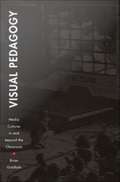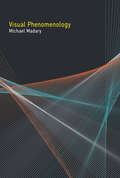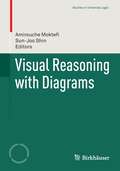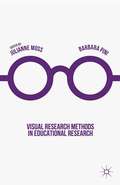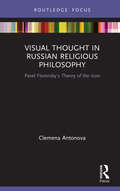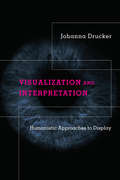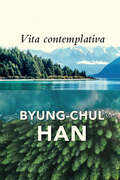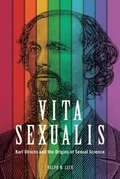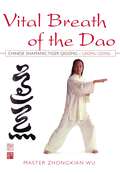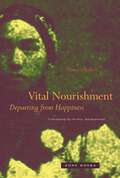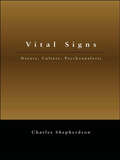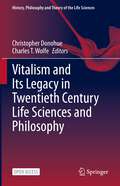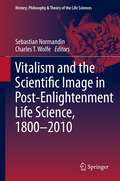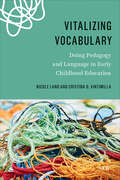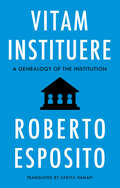- Table View
- List View
Visual Pedagogy: Media Cultures in and Beyond the Classroom
by Brian GoldfarbIn classrooms, museums, health clinics and beyond, the educational uses of visual media have proliferated over the past fifty years. Film, video, television, and digital media have been integral to the development of new pedagogical theories and practices, globalization processes, and identity and community formation. Yet, Brian Goldfarb argues, the educational roles of visual technologies have not been fully understood or appreciated. He contends that in order to understand the intersections of new media and learning, we need to recognize the sweeping scope of the technologically infused visual pedagogy--both in and outside the classroom. From Samoa to the United States mainland to Africa and Brazil, from museums to city streets, Visual Pedagogy explores the educational applications of visual media in different institutional settings during the past half century. Looking beyond the popular media texts and mainstream classroom technologies that are the objects of most analyses of media and education, Goldfarb encourages readers to see a range of media subcultures as pedagogical tools. The projects he analyzes include media produced by AIDS/HIV advocacy groups and social services agencies for classroom use in the 1990s; documentary and fictional cinemas of West Africa used by the French government and then by those resisting it; museum exhibitions; and TV Anhembi, a municipally sponsored collaboration between the television industry and community-based videographers in São Paolo, Brazil. Combining media studies, pedagogical theory, and art history, and including an appendix of visual media resources and ideas about the most productive ways to utilize visual technologies for educational purposes, Visual Pedagogy will be useful to educators, administrators, and activists.
Visual Phenomenology
by Michael MadaryIn this book, Michael Madary examines visual experience, drawing on both phenomenological and empirical methods of investigation. He finds that these two approaches -- careful, philosophical description of experience and the science of vision -- independently converge on the same result: Visual perception is an ongoing process of anticipation and fulfillment. Madary first makes the case for the descriptive premise, arguing that the phenomenology of vision is best described as on ongoing process of anticipation and fulfillment. He discusses visual experience as being perspectival, temporal, and indeterminate; considers the possibility of surprise when appearances do not change as we expect; and considers the content of visual anticipation. Madary then makes the case for the empirical premise, showing that there are strong empirical reasons to model vision using the general form of anticipation and fulfillment. He presents a range of evidence from perceptual psychology and neuroscience, and reinterprets evidence for the two-visual-systems hypothesis. Finally, he considers the relationship between visual perception and social cognition. An appendix discusses Husserlian phenomenology as it relates to the argument of the book.Madary argues that the fact that there is a convergence of historically distinct methodologies itself is an argument that supports his findings. With Visual Phenomenology, he creates an exchange between the humanities and the sciences that takes both methods of investigation seriously.
Visual Phenomenology
by Michael MadaryPhenomenological and empirical methods of investigating visual experience converge to support the thesis that visual perception is an ongoing process of anticipation and fulfillment. In this book, Michael Madary examines visual experience, drawing on both phenomenological and empirical methods of investigation. He finds that these two approaches—careful, philosophical description of experience and the science of vision—independently converge on the same result: Visual perception is an ongoing process of anticipation and fulfillment.Madary first makes the case for the descriptive premise, arguing that the phenomenology of vision is best described as on ongoing process of anticipation and fulfillment. He discusses visual experience as being perspectival, temporal, and indeterminate; considers the possibility of surprise when appearances do not change as we expect; and considers the content of visual anticipation. Madary then makes the case for the empirical premise, showing that there are strong empirical reasons to model vision using the general form of anticipation and fulfillment. He presents a range of evidence from perceptual psychology and neuroscience, and reinterprets evidence for the two-visual-systems hypothesis. Finally, he considers the relationship between visual perception and social cognition. An appendix discusses Husserlian phenomenology as it relates to the argument of the book.Madary argues that the fact that there is a convergence of historically distinct methodologies itself is an argument that supports his findings. With Visual Phenomenology, he creates an exchange between the humanities and the sciences that takes both methods of investigation seriously.
Visual Politics and North Korea: Seeing is Believing (Interventions)
by David ShimIn the realm of international relations, there are seemingly few states like North Korea. Whether it is the country’s human rights situation, its precarious everyday life or its so-called foreign policy of coercion and nuclear brinkmanship, no matter what this ‘pariah’ nation says and does it affects the state and stability of regional and global politics. But what do we know about North Korea and how do we come to know it? This book argues that visual imagery plays a decisive role in this operation. By discussing two exemplary areas – everyday photography and satellite imagery – the book takes into account the role of images in the way that particular issues related to North Korea are understood in contemporary geopolitics. Images work. They do something by evoking a particular perspective of what is shown in them, allowing only specific ways of seeing and knowing. In this sense, images are deeply political. Individual methodological usages in the book can provide a procedural basis from which to start or rethink further studies on visuality, both in IR and beyond. It also opens an innovative path for future studies on East Asia, making the book attractive to a range of specialists and thus holding an appeal beyond the boundaries of a single discipline.
Visual Reasoning with Diagrams
by Sun-Joo Shin Amirouche MoktefiLogic, the discipline that explores valid reasoning, does not need to be limited to a specific form of representation but should include any form as long as it allows us to draw sound conclusions from given information. The use of diagrams has a long but unequal history in logic: The golden age of diagrammatic logic of the 19th century thanks to Euler and Venn diagrams was followed by the early 20th century's symbolization of modern logic by Frege and Russell. Recently, we have been witnessing a revival of interest in diagrams from various disciplines - mathematics, logic, philosophy, cognitive science, and computer science. This book aims to provide a space for this newly debated topic - the logical status of diagrams - in order to advance the goal of universal logic by exploring common and/or unique features of visual reasoning.
Visual Representations in Science: Concept and Epistemology (History and Philosophy of Technoscience)
by Nicola MößnerVisual representations (photographs, diagrams, etc.) play crucial roles in scientific processes. They help, for example, to communicate research results and hypotheses to scientific peers as well as to the lay audience. In genuine research activities they are used as evidence or as surrogates for research objects which are otherwise cognitively inaccessible. Despite their important functional roles in scientific practices, philosophers of science have more or less neglected visual representations in their analyses of epistemic methods and tools of reasoning in science. This book is meant to fill this gap. It presents a detailed investigation into central conceptual issues and into the epistemology of visual representations in science.
Visual Research Methods in Educational Research
by Barbara Pini Julianne MossHave you noticed there is a burgeoning take up of visual research in education? Are you considering using visual research as part of your next research project or revitalising your research methods course? For researchers who are new to the field of VRMs in education there is little critical literature on the subject. This book addresses the gap in the literature and brings together some of the leading educational researchers engaging and reflecting on the visual from Australia, the UK and Canada. Encapsulated in a single volume, this book sets out theoretically grounded discussions of the possibilities and challenges of the approach for educational researchers around four key themes: images of schooling, performing pedagogy, power and representation and ethical issues in educational research.
Visual Rhetorics of Communist Romania: Life Under the Totalitarian Gaze
by Adriana CordaliVisual Rhetorics of Communist Romania: Life under the Totalitarian Gaze offers personal accounts and theoretical insight into the Cold War era when little information about life beyond the Iron Curtain could transpire to the West. Adriana Cordali develops a unique visual rhetorical theory for analyzing communist totalitarian propaganda and the resistance to it, and reveals the deliberate, strategic in/visibilities the rhetoric of power engaged in. Building upon the local history, ideology, and politics of the regime imposed after WWII, she identifies propaganda’s rhetorical features, visual tropes, and symbols and examines striking photographs and print materials from Ceaușescu’s regime (1966-1989) and the time of regime change (1989-1990), as well as an award-winning Romanian film that depicts women’s life at the time. Converging visual rhetoric and culture with history and politics, Visual Rhetorics of Communist Romania is a first book of this kind and will interest readers of rhetoric and communication, visual rhetoric, and political discourse in the region.
Visual Thinking
by Rudolf ArnheimFor thirty-five years Visual Thinking has been the gold standard for art educators, psychologists, and general readers alike. In this seminal work, Arnheim, author of The Dynamics of Architectural Form, Film as Art, Toward a Psychology of Art, and Art and Visual Perception, asserts that all thinking (not just thinking related to art) is basically perceptual in nature, and that the ancient dichotomy between seeing and thinking, between perceiving and reasoning, is false and misleading. An indispensable tool for students and for those interested in the arts.
Visual Thought in Russian Religious Philosophy: Pavel Florensky's Theory of the Icon (Routledge Focus on Religion)
by Clemena AntonovaThis book considers a movement within Russian religious philosophy known as "full unity" (vseedinstvo), with a focus on one of its main representatives, Pavel Florensky (1882–1937). Often referred to as "the Russian Leonardo," Florensky was an important figure of the Russian religious renaissance around the beginning of the twentieth century. This book shows that his philosophy, conceptualized in his theory of the icon, brings together the problem of the "religious turn" and the "pictorial turn" in modern culture, as well as contributing to contemporary debates on religion and secularism. Organized around the themes of full unity and visuality, the book examines Florensky’s definition of the icon as "energetic symbol," drawing on St. Gregory Palamas, before offering a theological reading of Florensky’s theory of the pictorial space of the icon. It then turns to Florensky’s idea of space in the icon as Non-Euclidean. Finally, the icon is placed within wider debates provoked by Bolshevik cultural policy, which extend to current discussions concerning religion, modernity, and art. Offering an important contribution from Russian religious philosophy to issues of contemporary modernity, this book will be of interest to scholars of religious philosophy, Russian studies, theology and the arts, and the medieval icon.
Visual and Cultural Identity Constructs of Global Youth and Young Adults: Situated, Embodied and Performed Ways of Being, Engaging and Belonging (Routledge Research in Cultural and Media Studies)
by Fiona BlaikieThis collection brings together the ideas of key global scholars focusing on the lives of youth and young adults, examining their visual and cultural identity constructs. Embracing an international perspective encompassing the Global North and Global South, chapters explore expressions and performances of youth and young adults as shifting and entangled, in and through the clothed body, gender, sexuality, race, artistic and pedagogical making practices, in spaces and places, framed by new materialism, social media, popular and material culture. The overarching emphasis of the collection is on youth and young adults’ strategies for engaging in and with the world, becoming a someone, and belonging, in settings that include a juvenile arbitration program, an artist community, high schools, universities, families and social media. This truly interdisciplinary and international collection will have resonance not just within cultural and media studies, but also in education, anthropology, sociology, gender studies, child and youth studies, visual culture, and communication studies.
Visualization and Interpretation: Humanistic Approaches to Display
by Johanna DruckerAn analysis of visual epistemology in the digital humanities, reorienting the creation of digital tools within humanities contexts.In the several decades since humanists have taken up computational tools, they have borrowed many techniques from other fields, including visualization methods to create charts, graphs, diagrams, maps, and other graphic displays of information. But are these visualizations actually adequate for the interpretative approach that distinguishes much of the work in the humanities? Information visualization, as practiced today, lacks the interpretivist frameworks required for humanities-oriented methodologies. In this book, Johanna Drucker continues her interrogation of visual epistemology in the digital humanities, reorienting the creation of digital tools within humanities contexts.
Vita Contemplativa: In Praise of Inactivity
by Byung-Chul HanIn our busy and hurried lives, we are losing the ability to be inactive. Human existence becomes fully absorbed by activity – even leisure, treated as a respite from work, becomes part of the same logic. Intense life today means first of all more performance or more consumption. We have forgotten that it is precisely inactivity, which does not produce anything, that represents an intense and radiant form of life. For Byung-Chul Han, inactivity constitutes the human. Without moments of pause or hesitation, acting deteriorates into blind action and reaction. When life follows the rule of stimulus–response and need–satisfaction, it atrophies into pure survival: naked biological life. If we lose the ability to be inactive, we begin to resemble machines that simply function. True life begins when concern for survival, for the exigencies of mere life, ends. The ultimate purpose of all human endeavour is inactivity. In a beautifully crafted ode to the art of being still, Han shows that the current crisis in our society calls for a very different way of life: one based on the vita contemplative. He pleads for bringing our ceaseless activities to a stop and making room for the magic that happens in between. Life receives its radiance only from inactivity.
Vita Sexualis: Karl Ulrichs and the Origins of Sexual Science
by Ralph M. LeckKarl Ulrichs's studies of sexual diversity galvanized the burgeoning field of sexual science in the nineteenth century. But in the years since, his groundbreaking activism has overshadowed his scholarly achievements. Ulrichs publicly defied Prussian law to agitate for gay equality and marriage, and founded the world's first organization dedicated to the legal and social emancipation of homosexuals. Ralph M. Leck returns Ulrichs to his place as the inventor of the science of sexual heterogeneity. Leck's analysis situates sexual science in a context that includes politics, aesthetics, the languages of science, and the ethics of gender. Although he was the greatest nineteenth-century scholar of sexual heterogeneity, Ulrichs retained certain traditional conjectures about gender. Leck recognizes these subtleties and employs the analytical concepts of modernist vita sexualis and traditional psychopathia sexualis to articulate philosophical and cultural differences among sexologists. Original and audacious, Vita Sexualis uses a bedrock figure's scientific and political innovations to open new insights into the history of sexual science, legal systems, and Western amatory codes.
Vita contemplativa: Elogi de la inactivitat
by Byung-Chul HanUna poderosa crida a abandonar la vida hiperactiva per recuperar l'equilibri i la riquesa interior. Estem perdent la nostra capacitat de no fer res. La nostra existència és absorbida per l'activitat i, per tant, completament explotada. Atès que només percebem la vida en termes de rendiment, tendim a entendre la inactivitat com un dèficit, una negació o una absència d'activitat quan es tracta, ben al contrari, d'una interessant capacitat independent. Byung-Chul Han indaga en els beneficis, l'esplendor i la màgia de l'ociositat i dissenya una nova forma de vida que inclogui moments contemplatius amb els quals poder afrontar la crisi actual de la nostra societat i frenar la nostra pròpia explotació i la destrucció de la naturalesa.
Vital Breath of the Dao
by Zhongxian Wu Master Zhongxian WuImmersing the reader in Daoist philosophy and its impact on life, this new edition of Vital Breath of the Dao by Master Zhongxian Wu is a fully illustrated guide to qigong, a way of physical and spiritual cultivation, and a way of life. The book includes the historical background, practical application, underlying principles and techniques of Daoist cultivation practices to bolster health and intensify spiritual connection to universal energy. Lineage holder Master Zhongxian Wu uses storytelling and a wealth of practical examples to introduce powerful qigong and internal alchemy methods and offers previously unseen personal stories to deepen his explanation of Daoist philosophy.
Vital Breath of the Dao: Chinese Shamanic Tiger Qigong - Laohu Gong
by Zhongxian WuVital Breath of the Dao is a fully illustrated guide to the historical background, practical application, underlying principles and techniques of Qigong, a way of physical and spiritual cultivation, and a way of life. Chinese Shamanic Tiger Qigong is a uniquely potent practice designed to bolster health and deepen spiritual connection to universal energy. Lineage holder Master Zhongxian Wu uses story-telling and a wealth of practical examples to introduce this powerful 24-movement Qigong form, which combines the traditions of ancient shamanism, Confucianism, Daoism, classical Chinese medicine, and the martial arts. An excellent introduction for Qigong beginners, the book will also be of interest to experienced practitioners, students of classical Chinese Medicine and anyone interested in Classical Chinese culture and anthropology.
Vital Forces, Teleology and Organization: Philosophy of Nature and the Rise of Biology in Germany (History, Philosophy and Theory of the Life Sciences #21)
by Andrea GambarottoThis comprehensive account of vitalism and the German philosophy of nature in the eighteenth century proposes an innovative thesis. The author restates the theories formulated by the G#65533;ttingen School, but also shows that some of its central tenets are drawn directly from the Naturphilosophie developed in Jena. In this sense the Biologie consists substantially of a compilation of theories elaborated in the previous decades, yet Treviranus rearranges them in a unitary framework and interprets them with a peculiar emphasis on the interaction between organism and environment. On the basis of this new approach he was the first naturalist in the German speaking world to sketch the outline of a theory concerned with the historical transformation of living forms. The book begins by considering the problem of generation, focussing on the debate involving Wolff, Blumenbach, Kant and Reil on the notion of "formative force. " Readers are invited to engage with the question of the origin of form and the epistemological status of the Bildungkraft as a principle of organization. The second chapter is concerned with the problem of functions and shows how this debate intersected Haller's theory on the vital properties of nerves and fibers. Readers are shown how Blumenbach and Kielmeyer both understand the animal kingdom as a graded series of organisms characterized by increasing functional complexity. The problem of classification is treated in the third chapter, showing how this model was developed in Goethe's morphology, Schelling's Naturphilosophie and Oken's comparative anatomy. The author explores their common character, which is an understanding of classification based on the idea of a unity of plan connecting all living forms with one another, and that of living nature as a universal organism. Finally, an analysis of the fundamental tenets of Treviranus' Biologie shows how the three instances of the pre-biological discourse on living beings converged as unified disciplinary matrix of a general biology. This overall account and its innovative thesis will be of interest to scholars of classical German philosophy, particularly those researching the philosophy of nature and the history and philosophy of biology.
Vital Nourishment: Departing from Happiness
by François JullienAn intellectual history of the concept of life and body politics in Chinese philosophyThe philosophical tradition in the West has always subjected life to conceptual divisions and questions about meaning. Although this process has given rise to a rich history of inquiry, it proceeds too fast, contends François Jullien. In its anxiety about meaning, Western thinkers since Plato have forgotten simply to experience life.In Vital Nourishment, Jullien slows down and begins to think about life from a point outside of Western inquiry, using the third- and fourth-century BCE Chinese thinker Zhuangzi as a foil in this installment of his continuing project of plumbing the philosophical divide between Eastern and Western thought.The question of how to &“feed life,&” or nourish it, is the point of departure for the Chinese tradition that Jullien locates in Zhuangzi. Life is something that passes through each of us, and we have a duty to become amenable to its ebbs and flows. We must cultivate a sense of being adequate to it so that we can house it.Exploring notions of breath, energy, and immanence, Jullien reopens a vibrant space of intellectual exchange between East and West. In doing so, he refuses to commit to a rigid thesis of meaning, and his text unfolds as an elegant process that begins to mirror the very type of thought he explores.While his inquiry is certainly weighted toward reinvigorating Western thought with ideas from the East, Jullien points out that this approach is intellectually and politically imperative at present. Against the self-help industry, which pursues an opportunistic simulacrum of this type of intellectual exchange, Jullien seeks to create a space of mutual inquiry that maintains the integrity of both Eastern and Western thinking. Vital Nourishment is therefore both a rich intellectual historical journey and a text very much attuned to the philosophical politics of the present.
Vital Signs: Nature, Culture, Psychoanalysis
by Charles ShepherdsonFirst published in 2000. Routledge is an imprint of Taylor & Francis, an informa company.
Vital Strife: Sleep, Insomnia, and the Early Modern Ethics of Care
by Benjamin ParrisVital Strife examines the close yet puzzling relationship between sleep and ethical care in early modernity. The plays, poems, and philosophical essays at the heart of this book—by Jasper Heywood, William Shakespeare, Edmund Spenser, John Milton, and Margaret Cavendish—explore the unconscious motions of corporeal life and the drowsy forms of sentience at the boundaries of human thought and intentionality. Benjamin Parris shows how these writers, although trained under the Renaissance humanist paradigm of attentive care, begin to dissolve the humanist coupling of virtue with vigilance by giving credence to the vital power of sleep. In contrast to humanist thinkers who equated sleep with carelessness, these writers draw on the ancient Stoic principle of oikeiôsis—the process of orienting the living being toward its proper objects of care, beginning with itself—in asserting the value of sleep, while underscoring insomnia's threat to the ethical flourishing of persons and polity alike. Parris offers an important revaluation of Stoic philosophy, which has too often been misconstrued as renouncing feeling and sympathetic connection with others. With its striking new account of the reception of Stoicism and attitudes toward sleep and sleeplessness in early modern thought, Vital Strife reveals the period's mounting concern with the regenerative nature of physical life and its elaboration of a newfound ethics of care.
Vitalism and Its Legacy in Twentieth Century Life Sciences and Philosophy (History, Philosophy and Theory of the Life Sciences #29)
by Charles T. Wolfe Christopher DonohueThis Open Access book combines philosophical and historical analysis of various forms of alternatives to mechanism and mechanistic explanation, focusing on the 19th century to the present. It addresses vitalism, organicism and responses to materialism and its relevance to current biological science. In doing so, it promotes dialogue and discussion about the historical and philosophical importance of vitalism and other non-mechanistic conceptions of life. It points towards the integration of genomic science into the broader history of biology. It details a broad engagement with a variety of nineteenth, twentieth and twenty-first century vitalisms and conceptions of life. In addition, it discusses important threads in the history of concepts in the United States and Europe, including charting new reception histories in eastern and south-eastern Europe. While vitalism, organicism and similar epistemologies are often the concern of specialists in the history and philosophy of biology and of historians of ideas, the range of the contributions as well as the geographical and temporal scope of the volume allows for it to appeal to the historian of science and the historian of biology generally.
Vitalism and the Scientific Image in Post-Enlightenment Life Science, 1800-2010
by Charles T. Wolfe Sebastian NormandinVitalism is understood as impacting the history of the life sciences, medicine and philosophy, representing an epistemological challenge to the dominance of mechanism over the last 200 years, and partly revived with organicism in early theoretical biology. The contributions in this volume portray the history of vitalism from the end of the Enlightenment to the modern day, suggesting some reassessment of what it means both historically and conceptually. As such it includes a wide range of material, employing both historical and philosophical methodologies, and it is divided fairly evenly between 19th and 20th century historical treatments and more contemporary analysis. This volume presents a significant contribution to the current literature in the history and philosophy of science and the history of medicine.
Vitalizing Vocabulary: Doing Pedagogy and Language in Early Childhood Education
by Nicole Land Cristina D. VintimillaThinking with language as a complex practice for educators, advocates, and researchers in early childhood education is a necessary gesture for countering the anti-intellectualism that designates early childhood education as a service providing custodial care. Vitalizing Vocabulary insists that early childhood education in Canada must unsettle our inherited demand for technocratic, instrumental, and accessible relations with language. At the collision of research and practice, Nicole Land and Cristina D. Vintimilla propose that cultivating playful, speculative, inventive, accountable, and answerable relations with words, concepts, and language is a critical move toward broadening early childhood education’s intellectual and interdisciplinary horizons. The book is organized into four actions that activate pedagogical grammars: reading, writing, citing, and speaking. Each section plays with the purposes of a glossary by proposing language that we would work to erase, reclaim, and introduce. This situates language as an ethical, political, and creative pedagogical process that puts specific relations, curricula, and subjectivities into motion. Vitalizing Vocabulary ultimately envisions a project of early childhood education where students, educators, pedagogists, researchers, community, and others share a common commitment to creating responsive, meaningful, ethical, and political pedagogies.
Vitam Instituere: A Genealogy of the Institution
by Roberto EspositoIn this book, Roberto Esposito continues his philosophical exploration of the relation between institutions and human life. Starting from the enigmatic Latin term vitam instituere, he charts its early emergence in modern philosophy and its development along a path that culminates in a novel understanding of the relationship between politics and life. Although the concept of institutio vitae originated in Roman law, it was Machiavelli who first conceived of politics as an instituent force. After Spinoza endowed the social imaginary with the capacity to institute relational life, Hegel was the first to view the ‘objective spirit’ as the space in which society and state are structured by institutional dynamics. However, in the Hegelian system it is the same dialectic – as an infinite process in which ideas materialize in reality – that expresses instituent power. Only by drawing from these modern roots, argues Esposito, can contemporary thought recognize the movement of institutions as the strategic nexus where the languages of philosophy, anthropology and politics intersect on a new horizon of meaning. This book completes the inquiry that Esposito began with Instituting Thought and Institution, offering a fresh view of the philosophical tradition from an instituent perspective. It will appeal to students and academics in philosophy and the humanities generally, and to anyone interested in contemporary philosophy and cultural theory.
